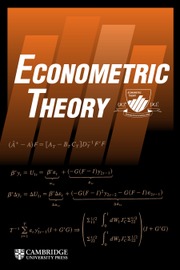Article contents
CONDITIONAL INFERENCE FOR POSSIBLY UNIDENTIFIED STRUCTURAL EQUATIONS
Published online by Cambridge University Press: 04 August 2003
Abstract
The possibility that a structural equation may not be identified casts doubt on measures of estimator precision that are usually used. Using the Fieller–Creasy problem for illustration, we argue that an observed identifiability test statistic is directly relevant to the precision with which the structural parameters can be estimated, and hence we argue that inference in such models should be conditioned on the observed value of that statistic (or statistics).
We examine in detail the effects of such conditioning on the properties of the ordinary least squares (OLS) and two-stage least squares (TSLS) estimators for the coefficients of the endogenous variables in a single structural equation. We show that (a) conditioning has very little impact on the properties of the OLS estimator but a substantial impact on those of the TSLS estimator; (b) the conditional variance of the TSLS estimator can be very much larger than its unconditional variance (when the identifiability statistic is small) or very much smaller (when the identifiability statistic is large); and (c) conditional mean-square-error comparisons of the two estimators favor the OLS estimator when the sample evidence only weakly supports the identifiability hypothesis but favor TSLS when that evidence moderately supports identifiability.
Finally, we note that another consequence of our argument is that the statistic upon which Anderson–Rubin confidence sets are based is in fact nonpivotal.We are grateful for the constructive comments offered by Peter Phillips and three anonymous referees that greatly improved the paper. Giovanni Forchini acknowledges support from ESRC grant NR00429424115.
Information
- Type
- Research Article
- Information
- Copyright
- © 2003 Cambridge University Press
References
REFERENCES
- 13
- Cited by

